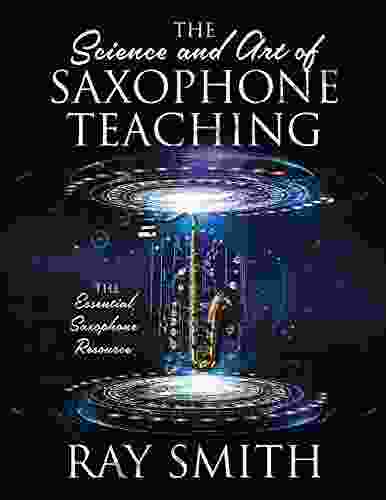The Science and Art of Saxophone Teaching: A Comprehensive Guide to Unlocking Musical Excellence


5 out of 5
| Language | : | English |
| File size | : | 12164 KB |
| Text-to-Speech | : | Enabled |
| Enhanced typesetting | : | Enabled |
| Word Wise | : | Enabled |
| Print length | : | 352 pages |
| Lending | : | Enabled |
| Screen Reader | : | Supported |
: Embracing a Holistic Approach to Saxophone Education
The saxophone, with its captivating sound and expressive capabilities, has enchanted musicians and audiences alike for over a century. As a saxophone teacher, you hold the key to unlocking the true potential of aspiring saxophonists, guiding them on a journey of musical discovery and growth.
The Science and Art of Saxophone Teaching is the definitive resource for saxophone educators, blending cutting-edge scientific research with time-honored pedagogical techniques. This comprehensive guide will empower you with a deep understanding of the physical, musical, and cognitive aspects of saxophone playing, enabling you to tailor your teaching to the unique needs of each student.
Chapter 1: The Physical Foundation: Embouchure, Breathing, and Fingerings
The physical foundation of saxophone playing is paramount. In this chapter, you will delve into the science of embouchure formation, exploring the optimal placement of the lips, teeth, and tongue. You will also learn about the principles of efficient breathing, ensuring that your students have the stamina and control to sustain their playing.
Furthermore, this chapter provides a detailed analysis of saxophone fingerings, covering both standard and extended techniques. By mastering these fingerings, your students will gain the dexterity and agility to navigate complex musical passages with ease.
Chapter 2: The Musical Landscape: Tone Production, Intonation, and Expression
Beyond the physical mechanics, saxophone playing is a deeply musical endeavor. This chapter focuses on the art of tone production, guiding you in developing your students' ability to produce a warm, resonant, and expressive sound.
You will also explore the intricacies of saxophone intonation, ensuring that your students play with impeccable accuracy. Furthermore, this chapter delves into the nuances of musical expression, empowering you to inspire your students to communicate emotions and tell captivating stories through their saxophone playing.
Chapter 3: The Cognitive Dimension: Ear Training, Sight Reading, and Improvisation
Saxophone playing is not merely about reproducing notes on a page; it requires a keen ear, strong sight-reading abilities, and the capacity to improvise. In this chapter, you will discover research-based techniques for developing your students' ear training skills, enabling them to identify pitches, intervals, and harmonies with confidence.
You will also learn about proven methods for teaching sight reading, equipping your students with the ability to navigate unfamiliar musical scores with ease. Additionally, this chapter provides a comprehensive guide to saxophone improvisation, encouraging your students to explore their musical creativity and express themselves uniquely.
Chapter 4: The Pedagogical Journey: Lesson Planning, Assessment, and Motivation
Effective saxophone teaching is not limited to technical instruction; it also involves skillful lesson planning, assessment, and motivation. This chapter offers practical guidance on developing engaging lesson plans that cater to the diverse learning styles and goals of your students.
You will also learn about various assessment techniques, enabling you to track your students' progress and provide them with constructive feedback. Furthermore, this chapter explores strategies for motivating students, fostering a passion for saxophone playing that will sustain them throughout their musical journey.
Chapter 5: The Wider Context: Performance Practice, Repertoire, and Career Development
The saxophone is not confined to the practice room or classroom; it is an instrument that thrives in the concert hall and beyond. This chapter provides insights into the art of performance practice, guiding you in preparing your students for successful recitals and auditions.
Additionally, you will explore a wide range of saxophone repertoire, from classical to jazz and contemporary works. This comprehensive guide will equip you with the knowledge to select and teach pieces that will captivate your students and challenge them to reach their full potential.
Finally, this chapter addresses career development for saxophonists, offering practical advice on pursuing a path in music as a performer, educator, or both. By understanding the industry and its opportunities, you can empower your students to make informed choices about their musical futures.
: Nurturing a Love of Saxophone Playing
The Science and Art of Saxophone Teaching is more than just a textbook; it is a testament to the transformative power of music education. By embracing the principles outlined in this book, you can inspire your students to fall deeply in love with saxophone playing, unlocking their musical potential and enriching their lives with the joy of making music.
Whether you are a seasoned saxophone teacher or just starting your journey, this comprehensive guide will provide you with the knowledge, skills, and inspiration to become a truly exceptional educator. By empowering your students with the science and art of saxophone playing, you will not only teach them a musical instrument but also nurture their creativity, confidence, and lifelong love of music.
Free Download your copy of The Science and Art of Saxophone Teaching today and embark on a journey that will transform both your saxophone students and yourself.
5 out of 5
| Language | : | English |
| File size | : | 12164 KB |
| Text-to-Speech | : | Enabled |
| Enhanced typesetting | : | Enabled |
| Word Wise | : | Enabled |
| Print length | : | 352 pages |
| Lending | : | Enabled |
| Screen Reader | : | Supported |
Do you want to contribute by writing guest posts on this blog?
Please contact us and send us a resume of previous articles that you have written.
 Book
Book Novel
Novel Page
Page Chapter
Chapter Text
Text Story
Story Genre
Genre Reader
Reader Library
Library Paperback
Paperback E-book
E-book Magazine
Magazine Newspaper
Newspaper Paragraph
Paragraph Sentence
Sentence Bookmark
Bookmark Shelf
Shelf Glossary
Glossary Bibliography
Bibliography Foreword
Foreword Preface
Preface Synopsis
Synopsis Annotation
Annotation Footnote
Footnote Manuscript
Manuscript Scroll
Scroll Codex
Codex Tome
Tome Bestseller
Bestseller Classics
Classics Library card
Library card Narrative
Narrative Biography
Biography Autobiography
Autobiography Memoir
Memoir Reference
Reference Encyclopedia
Encyclopedia Philomena Lynott
Philomena Lynott Connie Long
Connie Long Christopher Mitchell
Christopher Mitchell Noelle Frances Ferry
Noelle Frances Ferry Alan Riding
Alan Riding Aleks Harrison
Aleks Harrison Mandy Morton
Mandy Morton Akwaeke Emezi
Akwaeke Emezi Scott Alderman
Scott Alderman Alan Seaborn
Alan Seaborn Lex Martin
Lex Martin Lesley Mandel Morrow
Lesley Mandel Morrow Gerald E Sacks
Gerald E Sacks Assia Djebar
Assia Djebar Lana Kortchik
Lana Kortchik Aleksandr Solzhenitsyn
Aleksandr Solzhenitsyn Angelica Malin
Angelica Malin Alex Gadd
Alex Gadd Saeed N Jaffer
Saeed N Jaffer Alastair Reynolds
Alastair Reynolds
Light bulbAdvertise smarter! Our strategic ad space ensures maximum exposure. Reserve your spot today!

 Jaime MitchellUnlocking the Secrets of Cataract Surgery: A Comprehensive Exploration with...
Jaime MitchellUnlocking the Secrets of Cataract Surgery: A Comprehensive Exploration with...
 David Foster WallaceGreat Expectations With Colored Illustrations By George Cruikshank: A Visual...
David Foster WallaceGreat Expectations With Colored Illustrations By George Cruikshank: A Visual... W. Somerset MaughamFollow ·11.3k
W. Somerset MaughamFollow ·11.3k Jacob HayesFollow ·17.2k
Jacob HayesFollow ·17.2k Emmett MitchellFollow ·14.1k
Emmett MitchellFollow ·14.1k Aaron BrooksFollow ·9.4k
Aaron BrooksFollow ·9.4k Jerome PowellFollow ·17k
Jerome PowellFollow ·17k Arthur MasonFollow ·18.5k
Arthur MasonFollow ·18.5k Leo TolstoyFollow ·9.2k
Leo TolstoyFollow ·9.2k Ignacio HayesFollow ·15.4k
Ignacio HayesFollow ·15.4k

 W. Somerset Maugham
W. Somerset MaughamBach Dialogue With Modernity: A Journey Through Time and...
Prelude: Bach's Timeless...

 Ted Simmons
Ted SimmonsAsher Heroes At Heart Maryann Jordan: The Essential Guide...
Are you ready to...

 Paulo Coelho
Paulo CoelhoVienna Spies: Uncover the Hidden World of Espionage in...
Vienna has long...

 Herman Melville
Herman MelvilleThe Complete Guide to Orchestral Cymbal Playing:...
Step into the vibrant...

 Rubén Darío
Rubén DaríoEscape into a Holiday Haven with California Christmas...
Embark on a heartwarming and festive journey...
5 out of 5
| Language | : | English |
| File size | : | 12164 KB |
| Text-to-Speech | : | Enabled |
| Enhanced typesetting | : | Enabled |
| Word Wise | : | Enabled |
| Print length | : | 352 pages |
| Lending | : | Enabled |
| Screen Reader | : | Supported |








